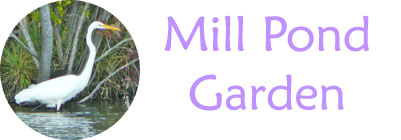Garden Open Day, Sunday, April 13th, 2025, 10:00 AM to 12:00 PM
13apr10:00 AM12:00 PMGarden Open Day, Sunday, April 13th, 2025, 10:00 AM to 12:00 PM
Event Details
Mill Pond Garden Celebrates early spring on April 13th One Ticket Admits one Vehicle with all of its Occuppants. No refunds – Rain or Shine. Mill
Event Details
Mill Pond Garden Celebrates early spring on April 13th
One Ticket Admits one Vehicle with all of its Occuppants. No refunds – Rain or Shine.
Mill Pond Garden welcomes visitors to Garden Open Day on Sunday, April 13th, from 10 am to noon to celebrate mid-spring beauty in full glory. Tickets, available on the website, millpondgarden.com, are twenty-five dollars admitting a car with up to six visitors. Mill Pond Garden, located at 31401 Melloy Court, Lewes, DE 19958, is an IRS-certified non-profit botanical garden on Red Mill Pond with a mission to provide holistic, beautiful, sustainable, and educational plantings for the enjoyment and education of the community. A horticulturist will be on duty to answer questions.
This particular point in spring includes the greatest variety of flowering species for Cape region gardens including early disease-proof azaleas, rhododendrons, hellebores, camellias, perennial spring ephemerals like trilliums, woodland phlox, and blue bells, Spireas, tulips, daffodils, Leucojum, iris, anemone blanda, wisteria, and flowering trees such as redbud, dogwood, sorrel tree, Hawthorne, and crabapple. Ground covers, including pachysandra, pulmonaria, herbs, and periwinkle, may still be in bloom. The garden has abundant birds, turtle basking logs, frogs, other wildlife, as well as beautiful butterfly koi and shubunkin fish in a tea garden pond and gazebo.
The native and non-native sedges, genus Carex, will be flowering and/or seeding at this time. Sedges are under-used groundcovers, great for adding color, texture, and wildlife benefit to beds or lawns. Some sedges are for sun and some for shade and come in colors blue, pink, brown, and every shade of green, ranging in height from a few inches up to a couple feet, with habits from straight-up leaves to arching, mounding shapes. Better nurseries offer a variety of sedges, grass-like clumping plants that can have wide leaves or very narrow ones. Sedges, which are semi-evergreen, can be used to replace a lawn, eliminating the need to mow except once a year in late February, though they are not as tough as lawn grasses and are not suitable for heavy foot traffic. Sedges can do well in pots.
Mill Pond Garden is designed to be a four season, year round garden demonstrating how that can be done here, with woody plants labeled and professional horticultural advice on hand. Most of the plants are natives. The non-native plants are beneficial species that provide not only ornamental beauty but also work well for the wildlife that the garden encourages, such as pollinators and birds. The garden provides water, habitat, nesting, over-wintering hibernaculums, and food species of plants, insects, and animals, all that is necessary as a Certified Wildlife Habitat by the National Wildlife Federation.
A holistic garden includes and encourages wildlife and native plants as well as satisfying the desire for beauty. A holistic garden will have both still and moving fresh water, native shrubs, key native trees like oak, black cherry and willow (the trees that attract abundant caterpillars in spring which feed baby birds), groundcovers, and broad, dense, mixed species beds, with both evergreen and deciduous plants, to provide habitat and food. It is gratifying to know that a holistic garden is the easiest to maintain and also the most satisfying and interesting to live in and with, the most like nature.
Isolating plants alone in a bed of mulch has been clearly demonstrated by research to not benefit the plants nor the soil’s health or performance. A mix of types of plants in a bed allows the maximum interplay of the microbial and fungal network underground that feeds and cares for all the plants in the bed.
Think of the beneficial soil fungi as the real gardeners or shepherds of the plants. The fungal mycelia form a network of white tubular threads that travel around all the roots of all the plants, branching out to all the other plants in the region as well, forming a connected community. Nutrients, both macro and micro, flow through these little tubes to where they are needed, and the fungus itself coordinates this exchange of nutrients, monitoring the plants for chemical needs. The mycelia and fungi can also pass water to a thirsty plant from one that has more than enough. Since the fungal mycelia feed off some of the carbohydrates (sap) produced by the plants, they benefit themselves by taking care of the plants and helping them thrive and grow. The fungi are the gardeners, the growers of the plants in nature and in your garden, sharing food and water, breaking down wastes, and recycling them.
Helping the beneficial fungi is the smartest goal for a knowing, successful gardener. Organic fertilizers help increase the fungal establishment and your plants. One of the best organics is composted horse manure.
Open Day will be a chance to luxuriate the senses in the huge variety of colors, scents, and shapes of the mid-spring garden, graced with the singing of birds and sound of splashing fountains and waterfalls, and lovely vistas of the great Red Mill Pond.
